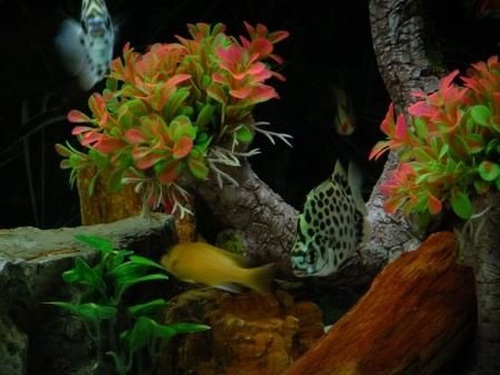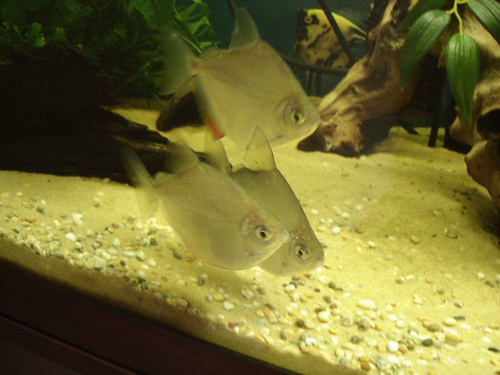FISH TO AVOID FOR PLANTED FRESHWATER TANKS

Updated
There is nothing more beautiful than a healthy, thriving planted freshwater tank.
Cultivating a freshwater planted tank is hard work and the last thing you want is to have all of that hard work destroyed by adding the wrong fish to your tank. To avoid this problem, do your research to determine which species to avoid when stocking a planted tank.
The truth of the matter is that some fish are more likely than others to completely destroy a planted tank. Cultivating a freshwater planted tank can be challenging but it can also be incredibly rewarding – as long as you go about it correctly. Nothing can compare to the beauty of a thriving freshwater tank full of live plants and healthy, happy fish. If you are going to take the time to set up and maintain a planted tank, you want to be sure that the fish you keep in the tank won’t destroy all of your hard work. Some species of fish are notorious for devouring or uprooting live plants so these species are best avoided if you plan to cultivate a planted tank.
Overview of Species to Avoid
Cultivating a thriving planted tank takes a great deal of time and effort, so the last thing you want to do is stock your tank with fish that will destroy all of your hard work. Though many fish will pick at live plants, eating bits of fish food or algae off the leaves, some species will actually devour the plants themselves. One of the worst species of freshwater planted tanks is the silver dollar fish. These fish are capable of decimating an entire tank full of live aquarium plants in one week or less. Buenos Aires tetras are another species that are not recommended for planted tanks – these tetras are voracious eaters, eating significantly more than most tetra species and having a tendency to consume aquarium plants. Other species which have a tendency to munch on live plants include monos, scats and goldfish.

In addition to these smaller species of freshwater fish, there are also some larger species you should look out for. The Leporinus genus of fishes tends to grow very quickly and they also have a tendency to destroy planted tanks. Many novice aquarium hobbyists make the mistake of adding these fish to their community tanks, not realizing their potential size and their appetite for live plants. Another species to watch out for is the plecostomus. Though this species makes a great addition to the community tank while small, as these fish mature they can become aggressive and may develop a habit of eating live plants. Other large species including Oscars and other cichlids may not eat live plants, but they have a habit of digging around in the substrate and rearranging their tanks. This digging behavior could damage the roots of delicate aquarium plants which is why you should use caution when adding live plants to a cichlid tank.
Species Profiles
Silver Dollar Fish – The silver dollar fish is a very easy species to care for which is part of the reason it is so popular. Unfortunately, many aquarium hobbyists do not realize the danger of keeping these fish in a planted tank. These fish can grow up to 6 inches long, so they are capable of eating large amounts of plant matter in a short period of time.
Buenos Aires Tetras – Though they may be small, growing only 2 ½ inches long, the Buenos Aires tetra can wreak havoc on the planted tank. These fish are best kept in groups with 6 or more of their own species and they tend to do well in community tanks with other South American species. This species of tetra will eat just about any type of aquatic plant except for Java Fern.

Monos – Monos are a group of fish that look very similar to Silver Dollar Fish, but they grow several inches larger. These fish subsist primarily on vegetable matter in the wild, so they are likely to eat live plants in the home aquarium if you do not provide them with enough vegetables to eat.
Scats – Scats are a type of fish that prefer brackish water. Though they are very likely to consume live plants in the tank, many types of aquatic plants do not do well in brackish conditions.
Goldfish – Goldfish can be tricky to keep in the home aquarium if you do not provide adequate space. Not only do these fish grow very large but they require high levels of dissolved oxygen. Goldfish are likely to feed on any plants in the tank, so if you must keep them in a planted tank use plants that grow quickly.
Recommended Species for Planted Tanks
Though there are definitely a few species you should avoid if you want to keep a planted freshwater tank, most species of freshwater tropical fish are safe for planted tanks. You do, however, need to be sure that the fish you choose are compatible with a planted environment. Some species of fish prefer to have plenty of open tank space for swimming and may not do well if the tank is completely filled with plants. Some species, on the other hand, will benefit from the shelter provided by large groups of live plants in the tank.
If you plan to keep a planted freshwater tank, you may want to select the fish before you select your plants. By selecting your fish first you can cater the tank to the needs of that particular species, choosing live plants that would be found in that species’ native habitat. The closer your tank environment mimics the natural habitat of your fish, the happier and healthier your fish are likely to be. If you aren’t concerned with creating an authentic tank environment, there are a number of species of fish that do well in planted tanks. Small species such as danios, livebearers, barbs and most tetras (with the exception of Buenos Aires tetras) do well in planted tanks. Larger species including gouramis, rainbowfish, discus fish and killifish would also do well.
Tips for Maintaining a Planted Tank
If you are going to go to all the effort required to cultivate a planted tank, you should do your best to do it correctly the first time. Do your research to ensure that none of the fish in your tank will destroy your live plants and be sure the plants you choose are compatible with your tank environment. In addition to these important preparations, there are also a few tips that can help ensure your success in cultivating a planted tank. In case you do have a few fish that like to munch on live plants, be sure to include some fast-growing species of plants such as hygrophila and cabomba. In cichlid tanks, you can avoid problems with your fish uprooting your plants by using floating plants that do not need to be rooted in substrate at all. Some popular species of floating plants include duckweed, hornwort, crystalwort and azolla. Another option is to root your live plants to pieces of driftwood so they will always have a firm foundation.
comments powered by Disqus







































































































































